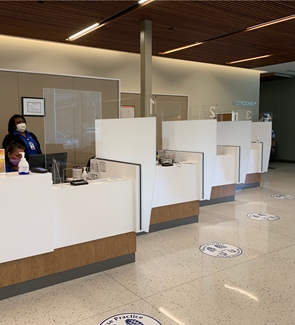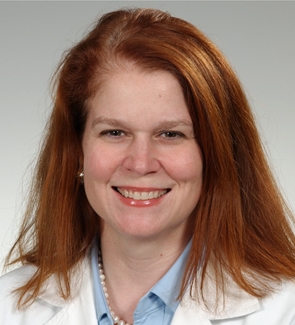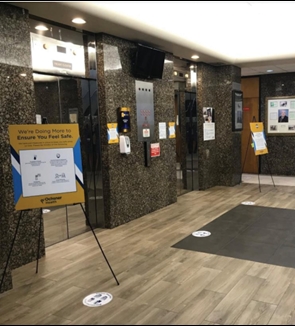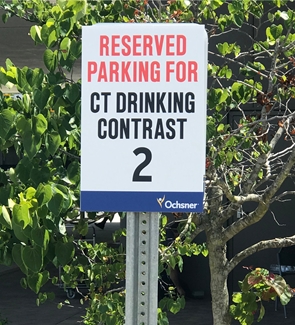Watch an Instagram Live interview with Dana H. Smetherman, MD, MPH, MBA, FACR.
Dressed in feathered costumes and sequins, throngs of revelers in New Orleans danced to the beat of marching bands, cheered flamboyant floats, and collected strands of gleaming beads as they celebrated the end of Mardi Gras on Tuesday, Feb. 25, 2020.
Not far away, in Ochsner Health System’s 19 owned and operated hospitals across Louisiana and Southern Mississippi, frontline caregivers didn’t realize that they were just weeks away from a tsunami of COVID-19 patients coming from the superspreader event on Fat Tuesday. The first Louisiana patient with COVID-19 was identified on March 9. By the end of April, there were nearly 30,000 cases and almost 2,000 deaths from COVID-19 in the state.
Dana H. Smetherman, MD, MPH, MBA, FACR, chair of the department of radiology at Ochsner Medical Center in New Orleans, led her radiology team through a deepening crisis as COVID-19 ravaged the region. “We didn’t know it at the time, but Mardi Gras was a petri dish, and we started to witness epidemiology in real time,” she says. “This virus moved through our community with mathematical precision. Before long, our mid-sized city was third in the country in both the number of confirmed cases and deaths per capita.”

Ochsner put markers on the floors for social distancing and installed Plexiglas at check-in desks. |
Smetherman has experience leading through crisis. She was on the front lines when Hurricane Katrina hit in 2005, breaching levees and causing widespread damage and deaths. She led her team of radiologists, technologists, and staff through the natural disaster’s peak and its aftermath — ultimately guiding her department back to normal. These days, the U.S. is in the middle of a different type of crisis, and it is unclear how long it will last or what its final toll will be. And Smetherman is once again on the front lines of disaster, forging a new path forward for imaging services.
Crisis Unfolding
Smetherman remembers the moment she first realized the magnitude of the health crisis sweeping her community. “I am a breast imager, but I still cover some general radiology shifts. I was on call the weekend before St. Patrick’s Day. As I was reading, I was seeing one chest radiograph after another to rule out COVID-19,” she recalls. “For me, it was then that I realized, ‘This is going to be very different.’ It was blowing up before my eyes.”
Smetherman called on her experience working through the Hurricane Katrina disaster to rapidly develop a plan, marshal necessary resources, and galvanize her team to action. “As a member of the lead response team for Hurricane Katrina, I had familiarity with this feeling of waking up to a whole different world than what it was a few days ago. Some of the same skills — focusing on communication and safety and maintaining optimism — kicked in quickly,” she says. “We have faced challenges before and come through them successfully. We knew it wasn’t going to be easy and that we needed to quickly rethink many things we had been doing. But we decided: Let’s focus on safety first and the other things will fall into place.”

After the Mardi Gras COVID-19 super-spreader event in New Orleans, Dana H. Smetherman, MD, MPH, MBA, FACR, led her radiology team in responding to the public health emergency. |
To advance that goal, Smetherman convened a meeting with hospital colleagues to devise a plan to optimize patient care. “I’m not only chair of radiology at our flagship hospital, I’m also associate medical director for several specialties, including emergency medicine, hospital medicine, and pulmonary critical care,” she says. “As such, I was in close contact with other departmental leaders, and we realized it was not going to be business as usual. We worked together to think processes through and build a plan to safely provide imaging for every patient in the emergency department (ED) and hospital. We were fortunate to have existing strong relationships with other departments, so there was no question of getting buy-in. Everybody was on the same page.” (Read more about Ochsner’s success in the Imaging 3.0 case study “
Collaborating Through Crisis”.)
Rapid Process Improvement
When cases peaked in Louisiana, the hospitals in Ochsner Health System were caring for more than 60% of COVID-19 inpatients in New Orleans and more than 30% in the state. At Ochsner’s flagship hospital, Ochsner Medical Center, cases initially doubled every two days. In the first two weeks, the hospital added a new COVID service every day, and it quickly had to double its number of ICU beds, build isolation rooms, and establish separate areas for negative and positive coronavirus patients in the EDs.
“Candidly, our situation was pretty dire, and we needed incredibly rapid process improvement to develop strategies to get through this crisis,” Smetherman says. “We had to immediately figure out how the radiology department could get our density of outpatients down and still conduct urgent imaging tests safely, without further spreading the virus.”
One challenge the radiology department faced was to institute a new ordering process and triage the outpatient schedule. “We’ve got patients scheduled for months out. Some are cancer follow-ups and others are people who’ve had back pain for six weeks and who don’t have urgent imaging needs,” Smetherman explains. “It was an all-hands-on-deck situation to figure out how to contact all of our patients and work with their providers to ensure we were only seeing stat patients, some of whom we knew were going to be COVID-19 positive.”

Ochsner Medical Center took critical steps to ensure that patients who come in for care during the pandemic feel safe. |
With this in mind, Smetherman and her team immediately looked to secure additional personal protective equipment (PPE). But, as with health systems around the country, obtaining enough equipment for care providers was an urgent challenge. “We leveraged our
innovationOchsner partners to start 3D printing face shields, and we leveraged our community connections to get more PPE,” Smetherman recalls. “We worked with state, local, and national governments to ensure that we had enough resources. As a system, we have robust analytics that we shared with government officials, so we could look at ventilator management across the whole city. We also have an active supply chain, so we started requesting additional ventilators before we even had the first case in the state.”
Focus on Safety
At Ochsner, much of the change brought to bear under the stress of the crisis involved keeping people safe. To reduce the risk of infection among radiologists, the department was eager to deploy at-home workstations. Initially, they deployed 15 remote workstations for a department of about 70 radiologists. Since they couldn’t get at-home workstations for everyone, they staggered schedules, implemented social distancing in the reading rooms, and deployed virtual communications with technologists and referring clinicians to minimize the number of people coming in and out of the department and reading rooms.
“We first redeployed existing workstations from reading rooms with the highest density of radiologists and residents,” explains Smetherman. “We prioritized those whose usual work assignments were most easily adapted to remote work — for example, those who did not need to do fluoroscopy, supervise contrast injections, or perform interventional procedures. Over time, we were able to purchase additional workstations, and every radiologist who wanted a home workstation was able to get one.”
Despite uncertainty under highly stressful circumstances, the radiology department was committed to maintaining the quality and service that partners and patients trusted. Staff radiologist Stephen I. Johnson, MD, says, “When this public health emergency first started, there was a concern that we might lose quality as we shifted to remote reading, but that hasn’t been the case. We’ve kept our staff safe while delivering the same level of quality service and remaining responsive to referrers.”
.jpg?h=325&w=295&hash=F7F5D4BB86A697BCB92F45BD451ABC94)
Staff radiologist Stephen I. Johnson, MD, says that keeping staff safe and continuing to provide top-quality, responsive service to referrers was key as COVID-19 ravaged the New Orleans region. |
Protecting the department’s technologists was another critical goal. As section head of Ochsner’s ultrasound department, Johnson’s immediate concern was for the safety of the technologists who would be in prolonged close contact with COVID-19 patients. “Ultrasound studies typically take 30 or 40 minutes, and our techs are within an arm’s reach of patients,” he says. “Initially, the techs were apprehensive about getting COVID-19, but we had PPE, face shields, and safety measures. After we got through the worst of it, none of our techs tested positive for antibodies. Obviously, that means we did something right.”
Johnson says that taking care of staff and listening to their concerns has been key to navigating a crisis of this magnitude. “We’re asking our staff to do things that are scary and stressful. We have to make sure we’re doing everything we can to protect them and also put them in a position of success,” he says.
Communication Essentials
One of the most critical ways to ensure staff success during a crisis is what Smetherman calls over-communication. “You have to use virtually every channel available to you,” she says. “I round a lot. I make sure I’m seeing everyone, and I ask them what they need. I’m on the phone, and I’m texting people. When I think about how I have approached leadership in this crisis, it’s: communicate, communicate, communicate.”
Smetherman and her team hold virtual staff meetings at least once a week, and they use the hospital’s electronic health record secure chat capability to communicate with technologists and colleagues across the system. The health system is also using video conferences for leadership calls and multidisciplinary meetings.
The use of technology has helped the team stay in touch while limiting personal interaction that can put people at risk. However, Smetherman says, “As a leader, your physical presence in a scary situation like this is absolutely critical. It would be difficult to lead something like this remotely. Your team has to know that you’re there for them; you’re alongside them. You can’t use your residents and techs as human shields. You have to show that the safety of your people and patients is your first priority.”
Morale Boost
Despite all of the safety protocols in place, Smetherman recognizes the staggering psychological effects of the pandemic on her team. “We’ve never had to face this kind of epic threat,” she emphasizes. “There’s a high rate of death, it’s contagious, and also our knowledge is constantly evolving. We are accustomed to having rigorous scientific data, and the uncertainty of this situation is troubling. When I was rounding in the early days of this, I found people in tears in the reading rooms.”

As the radiology department restarted imaging services, they asked critical questions like “How do we handle things like patients drinking contrast fluid?” |
Having overcome disasters like Hurricane Katrina in the past, Ochsner has a robust stress and psychological assistance program in place for employees. It includes quiet spaces, an employee hotline, and a social worker or psychologist on every rounding team. Smetherman has encouraged radiology team members to take full advantage of these resources. “Everybody’s doing the best they can right now. We have to be kind to each other and realize that we’re going to be stressed out and things are not going to be perfect. But we’re all in this together.”
Smetherman says that recognizing success and practicing gratitude helps keep morale high. “In our meetings, we not only talk about the number of patients who have died or who are on ventilators, but we talk about the number of patients who have been discharged,” she says. “We celebrate patients coming off of the ventilators and the decreased need for ventilators as we manage more patients with non-rebreather masks.”
While celebrating wins is important, Smetherman also says that it’s critical to remain humble, especially in a situation like the current pandemic, where so much is unknown. “I’ve had to acknowledge that my decisions are a best guess,” she says. “I didn’t have months to come up with a fabulous strategy and implementation plan. I’ve had to let my team know over and over again that I’m not going to be perfect, and I’m going to make mistakes. In a crisis, people at least appreciate that you’re able to show your own clay feet. Everybody looks to you as the leader, and if you are uncertain or stressed, it trickles down. We have to stay positive if we’re going to win this thing.”
Improvement Opportunity
After COVID-19 cases started decreasing in New Orleans, the radiology team turned its focus to restarting imaging services and making sure patients feel well cared for and safe. They put markers on the floors for social distancing and installed Plexiglas at check-in desks. At all of their sites, patients are greeted with consistent, Ochsner-branded stations for temperature and symptom checks. Masks are mandatory.
During the time when outpatient volumes were lower, Smetherman and her team worked to rapidly pilot a new workflow for outpatient imaging centers. They asked themselves questions like: How do we handle things like patients drinking contrast fluid? How much time will it take us to clean the units in between patients?
“We are trying to refrain from having patients in our waiting rooms,” Smetherman explains. “We ask patients to check in remotely and wait in their cars until they get a text message. Then a technologist meets them in the lobby for a temperature and wellness check and brings them straight back for their imaging; they change in the room and then go straight out after their exam is done. We have Ochsner-branded signs across our enterprise to let patients know the imaging exam area has been cleaned. We have whiteboards outside of the door that tell us the dwell time in the room, so we don’t bring the next patient back until we know it’s safe.”
Smetherman also notes that the pandemic has ushered in some welcomed advances. Her motto: “Never waste a good crisis.” This emergency has fast-tracked some initiatives, like telehealth and video visits, that the group has been eager to implement. And the radiology department continues to roll out home workstations in a phased approach. “We’re increasing the number of people who can work remotely because we don’t know what’s going to happen in the future,” Smetherman says. “Physicians are a tough group; they want to be there for their patients. This will be an important tool to help us communicate with referring providers and serve our patients going forward.”
Forward Momentum
It has been said that, “The secret of change is to focus all of your energy, not on fighting the old, but on building the new.” Smetherman echoes that sentiment when asked about transitioning to the next phase of the pandemic and developing strategies to deliver imaging services going forward.
“The way to succeed is not to try to rebuild the past,” she says. “Change is hard, but we must build for a new future. It’s not about taking old processes and trying to make them work. We must jump right into figuring out how to optimize the new. Challenges will undoubtedly arise, as will the need to adopt different leadership strategies. Nonetheless, I am optimistic that the lessons learned and knowledge gained in this first skirmish of our battle with COVID-19 will serve us well as our specialty and community navigate the uncharted waters ahead.”



.jpg?h=325&w=295&hash=F7F5D4BB86A697BCB92F45BD451ABC94)


